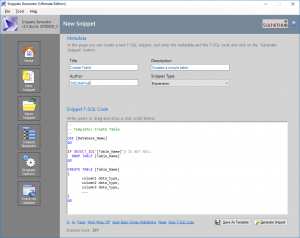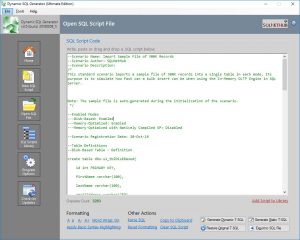In this article, we will be discussing about, how you can easily list all tables of a linked SQL Server database.
Introduction
There are many scenarios in the DBMSs world where you might need to use a linked server between two different SQL Server instances in order to execute direct queries between them. However, the majority of T-SQL auto-complete tools have difficulties to list the objects (i.e. tables) of the linked server’s database.
Custom Stored Procedure to Retrieve Linked SQL Server Database Tables
A way to see these objects, is to browse via SSMS’s Object Explorer. What about however if you want to have a quick view of all the available tables in the linked server’s database while writing your T-SQL script?
The answer is easy! You can do this by using the Information Schema Views. Below you will find a stored procedure that I created which can help you to list all the tables of linked server’s database.
Here’s the code:
------------------------------------------------------------------------------------------
-- Sample Code for Blog Post: Listing all Tables of a Linked Server's Database
-- Author: Artemakis Artemiou, Former Microsoft Data Platform MVP
--
-- Disclaimer: This is a sample code. Do not use it in Production Systems before properly
-- testing it. You bear sole responsibility for usage of any content of this T-SQL code.
-- You are responsible for any loss of data, loss of peace or any damages due to usage of
-- this code. Always take backup of your data.
------------------------------------------------------------------------------------------
USE [ENTER_DATABASE_NAME];
GO
CREATE PROCEDURE [dbo].[DBTableInfo] (@LinkedServerName varchar(50), @DBName varchar(50))
AS
--variables declaration
DECLARE @LinkedServerNameFiltered VARCHAR(50)
DECLARE @LinkedServerNameFound int
DECLARE @DBsFound int
DECLARE @DBNameFiltered varchar(50)
DECLARE @Command nvarchar(500)
--check if specified linked server exists
SET @LinkedServerNameFiltered=QUOTENAME(@LinkedServerName);
SET @LinkedServerNameFound=0;
SET @LinkedServerNameFound=(SELECT COUNT(*) FROM sys.servers s WHERE s.name=@LinkedServerName);
--report findings
IF @LinkedServerNameFound=0
BEGIN
PRINT 'Error: Linked server ' + @LinkedServerNameFiltered+ ' not found.';
RETURN;
END
--check if specified database exists
DECLARE @QUERY nvarchar(250);
SET @DBNameFiltered = QUOTENAME(@DBName,'''');
SET @DBsFound=0;
SET @QUERY='(SELECT @DBs=COUNT(*) FROM ' + @LinkedServerNameFiltered +'.[master].sys.sysdatabases s WHERE s.name='+@DBNameFiltered+')';
EXEC sp_executesql @QUERY, N'@DBs int OUTPUT', @DBs=@DBsFound OUTPUT;
--report findings
IF @DBsFound=0
BEGIN
PRINT 'Error: Database ' + @DBNameFiltered + ' not found.';
RETURN;
END
--construct dynamic T-SQL statement
SET @DBNameFiltered = QUOTENAME(@DBName);
SET @LinkedServerNameFiltered=QUOTENAME(@LinkedServerName);
SET @Command= 'SELECT TABLE_SCHEMA as TableSchema, TABLE_NAME as TableName,(''SELECT TOP 10 * FROM '+ @LinkedServerNameFiltered +'.'+ @DBNameFiltered +'.'' + QUOTENAME(TABLE_SCHEMA) + ''.'' + QUOTENAME(TABLE_NAME)) as SampleQuery
FROM ' + @LinkedServerNameFiltered+'.' + @DBNameFiltered+'.INFORMATION_SCHEMA.TABLES i WHERE i.TABLE_TYPE LIKE ''%TABLE%'' ORDER BY 1';
--execute the command
EXEC sp_executesql @command;
------------------------------------------------------------------------------------------
USE [ENTER_DATABASE_NAME]; GO EXEC [dbo].[DBTableInfo] 'LINKED_SERVER_NAME', 'LINKED_SERVER_DB' GO
The stored procedure displays three columns for each record: (i) Table Schema, (ii) Table Name, (iii) A sample query that can be executed and returns the top 10 rows for the specific table.
Sample output of the stored procedure:
Strengthen you SQL Server Development Skills – Enroll to our Online Course!
Feel free to check our online course titled “Essential SQL Server Development Tips for SQL Developers” (special limited-time discount included in link).
Sharpen your SQL Server database programming skills via a large set of tips on T-SQL and database development techniques. The course, among other, features over than 30 live demonstrations!

Recommended Online Courses:
- AI Essentials: A Beginner’s Guide to Artificial Intelligence
- SQL Server 2022: What’s New – New and Enhanced Features
- Working with Python on Windows and SQL Server Databases
- Introduction to Azure Database for MySQL
- Boost SQL Server Database Performance with In-Memory OLTP
- Introduction to Azure SQL Database for Beginners
- Essential SQL Server Administration Tips
- SQL Server Fundamentals – SQL Database for Beginners
- Essential SQL Server Development Tips for SQL Developers
- Introduction to Computer Programming for Beginners
- .NET Programming for Beginners – Windows Forms with C#
- SQL Server 2019: What’s New – New and Enhanced Features
- Entity Framework: Getting Started – Complete Beginners Guide
- Data Management for Beginners – Main Principles
- A Guide on How to Start and Monetize a Successful Blog
Check our Related SQL Server Development Articles:
- The set identity_insert Command in SQL Server
- The Import Flat File Wizard in SSMS v17.x
- Listing all Tables of a Linked Server’s Database
- How to Import and Export Unstructured Data in SQL Server – FileTables
- How to Import and Export Unstructured Data in SQL Server – FILESTREAM
- How to Import and Export Unstructured Data in SQL Server – The IMAGE Datatype
- Script that Returns SQL Server’s Version Name
- …more
Featured Database Productivity Tools
Develop T-SQL code faster with Snippets Generator: Create and modify T-SQL snippets for use in SQL Management Studio, fast, easy and efficiently.
Dynamic SQL Generator: Convert static T-SQL code to dynamic and vice versa, easily and fast.
Did you find this article useful and interesting? Feel free to leave your comment!
If you enjoy my SQL Server development tips and articles, I have something special just for you. It is one of my eBooks and it is called “Developing with SQL Server“. Check it out!
Subscribe to our newsletter and stay up to date with our latest articles on SQL Server and related technologies!
Check out our latest software releases! All our software tools have free trial versions to download.
Rate this article:
Reference: SQLNetHub.com (https://www.sqlnethub.com)
© SQLNetHub
Artemakis Artemiou is a seasoned Senior Database and AI/Automation Architect with over 20 years of expertise in the IT industry. As a Certified Database, Cloud, and AI professional, he has been recognized as a thought leader, earning the prestigious Microsoft Data Platform MVP title for nine consecutive years (2009-2018). Driven by a passion for simplifying complex topics, Artemakis shares his expertise through articles, online courses, and speaking engagements. He empowers professionals around the globe to excel in Databases, Cloud, AI, Automation, and Software Development. Committed to innovation and education, Artemakis strives to make technology accessible and impactful for everyone.




